Vibration Exercise Guide
Vibration exercise is a physical exercise that incorporates vibration stimulation to advance the effectiveness.
The key to vibration exercise is muscle training. Through the physiological activities of muscles, we can achieve various health benefits.
Vibration exercise poses should be designed to enable the vibration plate to effectively induce rapidly repeated skeletal muscle contractions. Muscle contractions activate our musculoskeletal and neuromuscular systems, also creating a skeletal pump effect that enhances our blood and lymph circulation.
- Vibration Exercise Poses
- Training Tips
- Vibration Exercise Mechanism
- Different Vibration Patterns
- Cautions
- Lateral Oscillation May Harm Your Knees
Vibration Exercise Poses
Due to its ground-laying style, a whole body vibration plate (linear vibration plate or pivotal oscillation plate) is more effective for training the muscles of lower limb, hip and lower back.
Some common physical exercise poses that we regularly use for enhancing our core strength and balance can work well on a whole body vibration plate. Below are these exercise poses that can effectively use the vibration stimulation.
| Vibration Training for Lower Body Muscles (Effective Use) | |
|---|---|
| Exercise Pose | Target Muscles Group |
| Squat | Muscles around knee joint |
| L-Squat | Muscles around hip and lower back muscles |
| Deadlift | Lower back muscles |
| Calf Raise | Calf muscles |
| Tiptoe | Foot Intrinsic muscles and plantar muscles |
A whole-body vibration plate can also be used for training upper body muscles, but the vibration stimulation is not very effectively utilized due to its ground-laying style. Below are some recommended vibration exercise poses for upper body muscle training.
| Vibration Training for Upper Body Muscles (Less Effective Use) | |
|---|---|
| Exercise Pose | Target Muscles Group |
| Push-up | Chest muscles and triceps |
| Reverse Push-up | Triceps and shoulder muscles |
| Plank | Upper back muscles |
| V-sit | Abdominal muscles |
Vibration Training Tips
- Squat
-
Squat is an excellent exercise to perform on a vibration plate. The additional rapidly repeated muscle contractions induced by vibration enhance the exercise effectiveness.
Compared to walking and jogging, vibration squats cause less impact and wear on your knee joint bones and cartilages. It is an effective and safe way to exercise muscles around knee joints.
Shallow Squat vs. Deep Squat[ Shallow squat] allows you to exercise muscles around the knee joints. It does not require a lot of strength and effort. You can hold a pair of dumbbells to increase the intensity if needed.
With enhance muscles around your knee joint, the overall functionality of your knee joints is improved.
[Deep squat] allows you to exercise muscles around both knee joints and hip joints, including posterior hip muscles (gluteal muscles) and thigh muscles. Deep squat requires more muscle strength and effort.
On deep squat pose, you should avoid strain the tendons and ligaments around your knees by not sticking out your knees too much. Adjust your pose and gravity center to bring back your knees.
Shallow squat is more suitable for senior or physically weak individuals.
People with good physical strength may hold additional weight to performance squat on a vibration plate to achieve more enhaned result.
- L-Squat
-
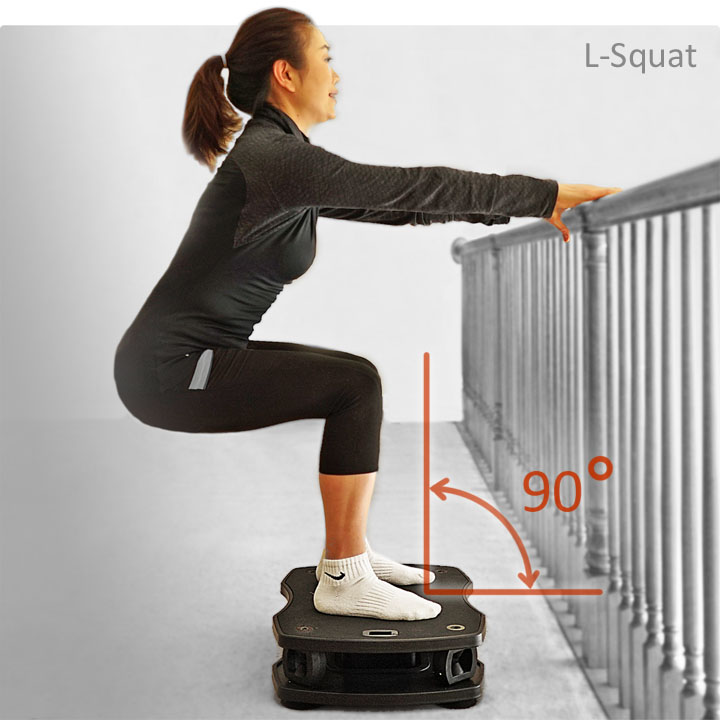
L-squat is a deep squat with your lower legs vertical to the ground. This pose requires the use of a handrail for balance.
Keeping your lower legs vertical helps prevent straining the tendons and ligaments around the knee joints.
You can djust your leg curling angle to fit your strength. The lower the hip, the more challenging.
L-squat allows you to concentrate muscle tension to your posterior hip muscles, anterior thigh muscles, and hamstring muscles. These three groups of muscles connect femur and pelvis. The fast pace contraction of these muscles produces the needed mechanical stimulation for bone growth at the femoral neck. People with osteoporosis should regularly exercise muscles around the hips to make femoral neck stronger and reduce the risk of fracture.
Enhanced gluteal muscles and thigh muscles also provide better support and protection to your hip joints.
- Deadlift
-
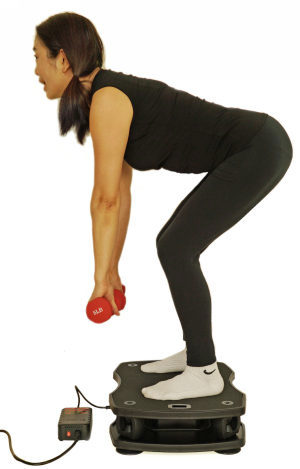
Deadlift exercises lower back muscles and muscles around the hips.
Be sure to hold your back straight to avoid improper stress to your lumbar spine.
When you perform deadlift on a vibration plate, most vibration is absorbed by the legs before reaching your lower back. Keeping your legs and pelvis tight and pressing your heels against the intensity center of the vibrattion plate to allow more vibration transmitted to your lower back.
Concentrating your mind to feel the muscles contraction on your lower back muscles, and adjust your pose and movement to enhance the muscle contraction.
Vibration deadlift can help ease lower back pain and enhance the lower back muscle. Strong muscles provide improved support to your lumbar spine.
Depending on your physical condition, you can perform deadlift with or without carrying a weight.
If you physical condition allows, you can carry some weight, like a pair of dumbbells for enhanced effectiveness.
- Calf-Raise
-
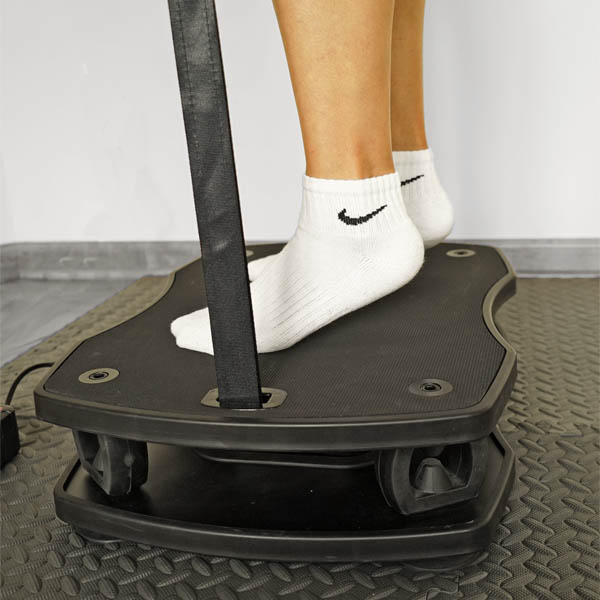
Vibration plates provide a very effective way to train calf muscles.
Performing calf-raise, you just naturally lift your heels. Your toes are slightly press again the vibration plate just to keep the balance. The tension is on your calf muscles.
Advanced user can perform single foot calf raise for a more aggressive balance training.
Calf Raise vs TiptoeCalf raise and tiptoe are two different type of exercises. They work different muscles and are performed differently.
Calf raise mainly concentrates on working posterior lower leg muscles, while tiptoe more concentrates on working foot intrinsic muscles.
Calf raise and tiptoe on a vibration plate best utilize the vibration stimulation, because your feet directly press against the vibration plate, the vibration is fully transmitted from the machine to your feet and up to the calves.
- Tiptoe
-
There is probably no better way to exercise your intrinsic foot muscles and plantar than performing tiptoe on a linear vibration plate.
Performing tiptoe, you raise your heels with your toes press hard against the vibration plate. Spreading your toes so to get the muscles on each digit trained.
Foot muscle training is often overlooked. When you wear comfortable shoes, you don't get much exercise on your foot muscles.
Foot muscles training is important for balance and prevent foot deformation.
Benefits and Tips of Training Foot Muscles on Vibration Plate
- Push-up
-
You can enhance your upper body muscle strength by doing push-up on a vibration plate.
Push-up mainly works your chest muscles and triceps. By adjusting your hands and arm position and angle, you can also exercise your shoulder muscles and back muscles.
Just like with plank posture, your lower body is mainly horizontal in a push-up posture, vibration does not actually transmit to the lower body muscles on a full push-up posture.
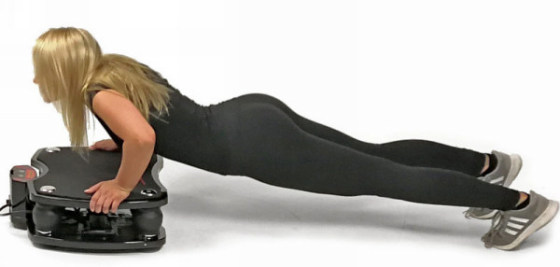
If a full push-up is too hard for you, you can do half-push-up. So that you can do more repetitions and allow vibration to work your chest muscles and triceps for a longer period of time, for therapeutic purpose.
- Reverse Push-up
-
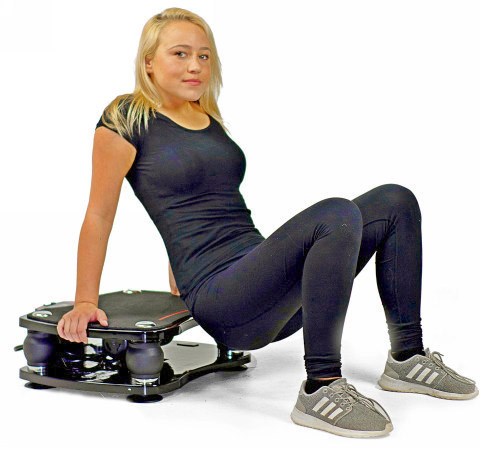
Reverse push-up works your triceps and shoulders. Performing reverse push-up on a vibration plate is more effective.
If it is too hard, you can rest your hip on the floor, but still push the vibration plate with your arm as much as you can to produce the needed muscle contraction.
To make it more easier, you can do isometric reverse push-up. Vibration will make it a dynamic exercise and increase the effectiveness.
Reverse push-up on a vibration plate can also help your relax your tense neck and back muscles (trapezius and rhomboids).
- Plank
-
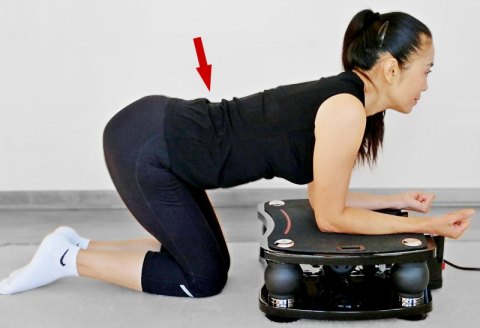
Through half-plank exercise, you can introduce vibration to your upper back muscles, especially to the rhomboid muscles.
Improved muscle condition and circulation can help ease your muscle pain between the shoulder blades.
Vibration stimulation changes the isometric exercise nature of plank. The fast pace muscle contraction makes plank exercise more efficient and effective.
Half-plank does not require strong core strength. Therefore you can hold the posture for a longer period of time and allow vibration to work your upper back muscles sufficiently. On a full plank posture, because the lower body are mainly horizontal, vibration does not actually transmit to the lower body muscles. In another words, your lower body muscles are not vibrated.
Relax your lower back muscles so the vibration can be more concentrated to your upper back muscles. Feel the contraction, and adjust the distance between the elbows to allow more vibration to work on your rhomboid muscles.
- V-sit
-
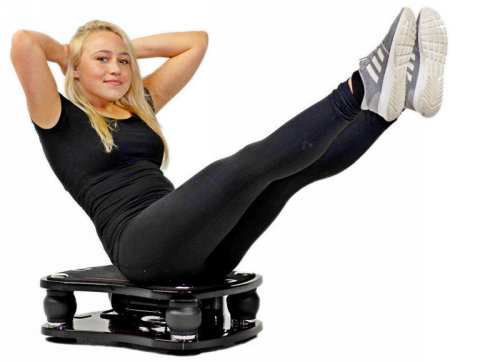
V-sit exercise targets all your abdominal muscles. Strong abdominal muscle improves core strength and balance.
Abdominal muscle contraction pulls rib cage, producing mechanical stimulation needed for rib bone growth.
Vibration stimulation changes the nature of V-sit from isometric exercise to dynamic exercise. The fast pace muscle contraction makes V-sit more efficient and effective.
V-sit is challenging and intensive for beginners. If it is too hard, you can do it with your legs bent.
Concentrate your mind on your abdominal muscles, adjust the posture to introduce more vibration stimulation for muscle contraction.
Vibration Exercise Mechanism
Vibration exercise should use the poses that allow the vibration plate to effectively induce rapidly repeated skeletal muscle contraction.
Vibration induces skeletal muscle contraction due to our skeletal muscle's instinct stretch reflex.
As a mechanism of maintaining body stability and balance, our skeletal muscle fibers (cells) naturally tend to keep a constant length. Therefore, when skeletal muscles are stretched, they spontaneously contract to resist the stretch. This is skeletal muscle's stretch reflex response.
The fast reciprocating movement of vibration can be used to stretch and relax skeletal muscles, and produce rapidly repeated muscle contraction.
This rapidly repeated muscle contraction effectively activates the muscles and the connecting tissues (tendons, ligaments, bones and nerves). The reaction exercises the musculoskeletal system and the neuromuscular system, enhancing their functionality. The tissue activities also promote the peripheral circulation of blood, lymph and interstitial fluids.
In order to produce muscle contraction, the direction (or a vector component of the direction) of vibration needs to be aligned with the length direction of the muscle fiber, to induce the muscle's stretch reflex response.
Therefore, when posing your body on a vibration plate, you would try to align your target skeletal muscles with the vibration direction. Muscle direction usually aligns the bone direction, mostly on vertical direction.
So now you know what vibration exercise poses are effective, what are not.
Exercise poses designed for strength and balance training are usually slow-motion or isometric. Such a nature is changed when vibration is incorporated in the exercise. Vibration stimulation adds dynamics, efficiency and effectiveness to the exercise.
Some vibration plate models designed to move on left-right lateral direction. Such a movement does not induce muscle contraction, and on the other hand, is harmful to knee joints.
Different Vibration Patterns
To better utilize your vibration plate, you need to know what kind of motion pattern your vibration plate provides, so that you can develop the proper exercise poses to get the needed muscle contraction. Exercise poses suitable for one motion pattern may not work well for another.
There are two distinctively different motion patterns depending on what type of vibration plate you have:
- Linear vibration
- pivotal oscillation
Below are exaggerated slow motion animations of the two types of vibration pattern. They interact with your body differently.
| Linear Vibration Plate (side view) |
Pivotal Oscillation Plate (front view) |
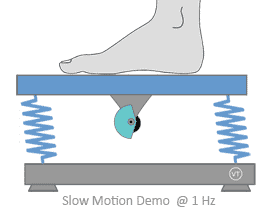 |
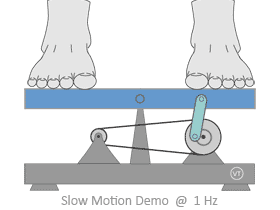 |
| High Frequency Low Amplitude |
Low Frequency High Amplitude |
Pivotal oscillation plate moves like a see-saw. Stepping on the center part of a pivotal oscillation plate is not a valid exercise pose, because the center of the plate does not move.
Caution
Vibration exercise pose needs to be designed to keep vibration from directly impacting your bones and cartilages.
Instead, the vibration exercise should be designed to only stretch your skeletal muscles, and let the muscle contraction to press the bones and cartilages.
Always keep your knee bent to avoid vibration from directly impacting your knee cartilage discs.
Adding vibration to physical exercise makes the exercise more effective due to the fast pace repetitive muscle contraction and the impact of extra G-force.
On the other hand, the repetitive movement and the extra G-force can also amplify the negative results if your exercise pose or the vibration movement is wrongly designed.
Although all kinds of body movements are the results of skeletal muscle contraction, some movements are not well supported by the design of our musculoskeletal structure. Habitual use of these not-well-supported movement can cause injury. Remember what happened in Dolphin Tale?
[Example] Lateral and twist movements on knee joint are not well supported by the muscle groups connected to the knee joint. Without muscle support, the movement can injure the ligaments and wear the cartilages. Lateral and twist movements on knee joint should be avoided by adjusting the pose, in a way that the movement is supported by the connected skeletal muscles.
Lateral Oscillation May Harm Your Knee Joints
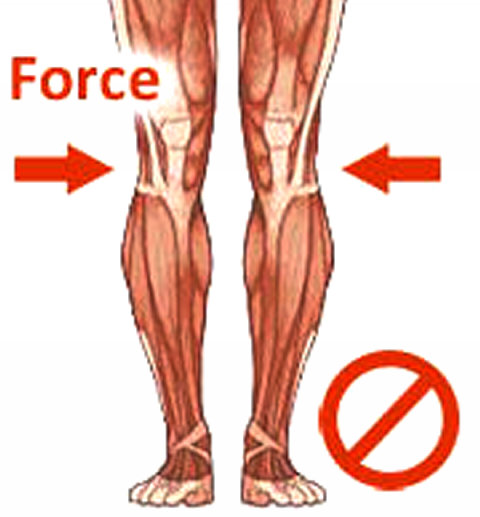
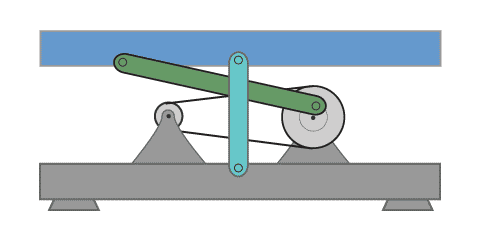
Some mixed motion vibration plates are designed with lateral oscillation motion. We believe using a lateral oscillation is harmful to knee joint. It causes the wear and tear between the patella (kneecap) and femur trochlear groove. It also stresses the knee ligaments (LCL, MCL, ACL and PCL) in a wrong way and can cause injury.
The musculoskeletal structure of our legs is designed for making up-and-down and forth-and-back movement. Left-and-right lateral movement on our knee joints is against their designed structure. This kind of posture should be avoided in our daily physical activities, let alone doing it on a repetitive motion vibration plate.
Lateral oscillation does NOT induce skeletal muscle contraction. It does not exercise muscles.
Always bent your knees when you are on a vibration plate.